The vast majority of wetsuits on the market are made from neoprene or a neoprene material blend.
Neoprene is a fantastic material to create affordable yet high-quality wetsuits due to its excellent material properties such as water resistance, strength, flexibility and durability.
Unfortunately, chlorinated pool water can damage your wetsuit with over-exposure.
It is best to avoid wearing a neoprene wetsuit in a chlorinated pool. Although there is no immediate effect, with time, the chlorine in the pool water will damage your wetsuit and the material will begin to degrade. To minimize this effect, always wash your wetsuit post-swim with fresh, clean water.
But how much time and exposure is needed before your wetsuit is affected?
I decided to put my wetsuit to the test and documented the amount of time I swam in my home pool in a new neoprene wetsuit over a summer season, noting the pool chlorine levels.
Below, I have shared my findings and have covered some of the key facts about wearing neoprene in chlorine water, including:
- What is neoprene?
- Are all wetsuits made of neoprene?
- What does chlorine do to wetsuits?
- Will chlorine damage my wetsuit? (Results & Findings)

What Is Neoprene?
Neoprene is a synthetic rubber and is one of the most common materials found in wetsuit production.
In fact, neoprene is found almost everywhere from car tyres to garden hoses. It is completely chemically manufactured and is not found naturally in the environment.
It is particularly effective as a wetsuit material because it is:
- cheap to produce.
- flexible
- resistant to water damage.
- stretchy and durable.
- warm and insulating
Are All Wetsuits Made Of Neoprene?
They make the vast majority of wetsuits from neoprene, but there are alternatives out there.
Because of environmental challenges, more and more suppliers are seeking alternative wetsuit materials that are not based on neoprene, for example, wetsuits made from Lavacore or eco wetsuits that are made from natural materials.
Unfortunately, most of these alternatives are still on the expensive side. It is hard to compete with neoprene on price in the present market.
Although neoprene wetsuits vary in price, if your wetsuit costs less than £100, there is a high chance that it is made from a simple synthetic neoprene.
If you are looking for an alternative to a neoprene wetsuit, have a look at this article that dives into the alternatives to wetsuits in greater detail, Are There Alternatives To Wetsuits?
What Does Chlorine Do To Wetsuits?
According to the experts, chlorine will accelerate the ageing of your wetsuit, causing the material to break down at a faster rate, which will make the wetsuit feel old and stiff before it’s time. [source]
In a nutshell, your expensive wetsuit will deteriorate at a much faster rate when exposed to chlorine and, as a result, will not last as long.
Will Chlorine Damage My Wetsuit? (I Tested It)
The science behind chlorine and how it interacts with a neoprene wetsuit is well documented and, as a result, all good wetsuit manufacturers will tell you to avoid using your neoprene wetsuit too much in chlorinated water.
I agree with these experts, but I was curious to test what would actually happen to my own wetsuit with long-term exposure to chlorine.
Because I have a pool in my garden, I documented a full season of wetsuit swimming, monitored the chlorine pool levels and observed the effect the chlorine had on my wetsuit.
The Neoprene Wetsuit Tested
In the interest of having a fair experiment, I purchased a new neoprene wetsuit so the neoprene material was fresh with no previous wear and tear.
Here is the 2mm/3mm neoprene wetsuit that I purchased from Osprey. It is a great wetsuit at a very affordable price.

Caring For My Wetsuit
After each swim, I washed the wetsuit in fresh clean water in order to remove the chlorine. I did not use any soaps or special cleaners; just clean fresh water.
All manufacturers recommend you do this, so it is natural to assume that anyone who swims in a wetsuit in chlorinated water will wash their wetsuit post-swim in clean water.
Your wetsuit will stink of chlorine if you don’t rinse it with fresh water and I really like a fresh wetsuit each time I swim!
Chlorine Pool Levels
Chlorine levels will vary between swimming pools, but there is a recommended safe chlorine level for swimming pools. [source]
Here is the average chlorine level in my home pool, measured with chlorine testing strips.
This is the level of chlorine that my neoprene wetsuit was exposed to for each swim, which is within the parameters of public swimming pools.
| Chlorine Measurement | Measured Levels |
|---|---|
| Free Chlorine | 2.0 – 4.0 ppm |
| Total Chlorine | 2.0 – 4.0 ppm |
Impact Of Chlorine On My Neoprene Wetsuit
| Wetsuit Tested | Number Of Pool Swims | Average Swim Length | Wetsuit Condition |
|---|---|---|---|
| Osprey | 50 | 40 minutes | Good |
Overall, the wetsuit performed well and was in good shape after this long-time exposure to chlorine.
Although it has faded just a bit, the condition is still very good with the material feeling like new.
The seams and stitching are all perfect, with very few signs of excessive wear.
The material does not feel as stretchy as a new wetsuit and is missing a little of the elasticity and bounce that you feel with a new wetsuit. To be honest, this is so minor it is not a problem for me.
Thankfully, the wetsuit does not smell of chlorine and that classic neoprene wetsuit smell is still there.
I can see that I will not get years out of my wetsuit if I continue to expose it to chlorine, but washing it well with fresh water after every swim has definitely prolonged its life.
In conclusion, three months of regular swimming in chlorinated water and my wetsuit is still in good shape.
Here are some pictures of how it looks. The central section is a thicker neoprene that has some markings, and you can see that it is faded.
Given that this wetsuit only had 50 swims, you would expect a “fresher look”, but it is still useable and I would classify it as being in used, but good condition. The wear and tear is just cosmetic for now.
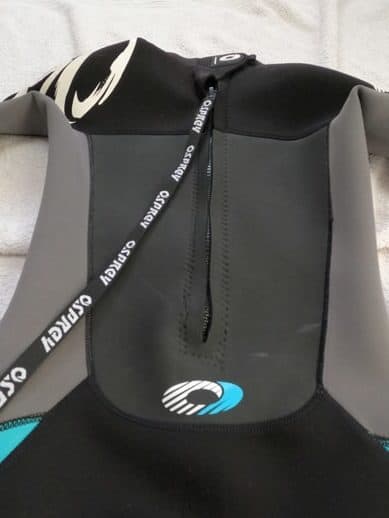
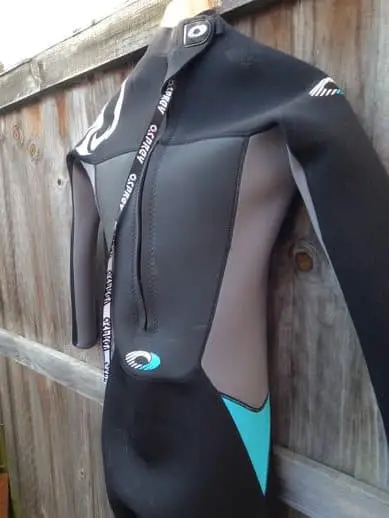
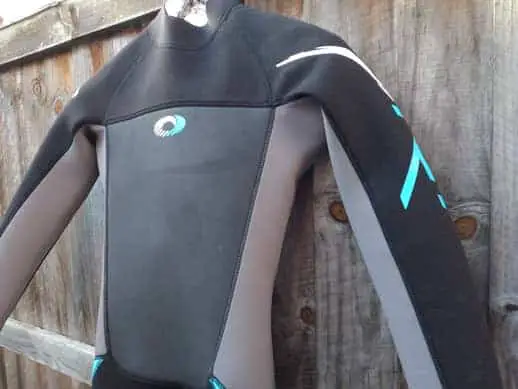
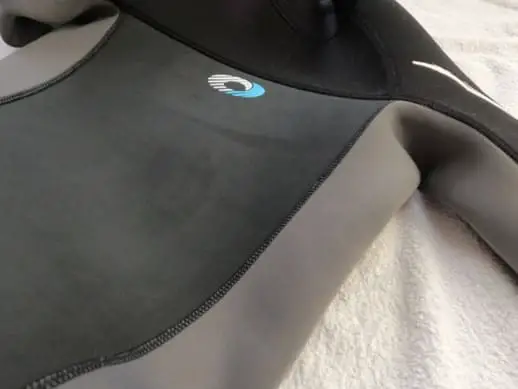
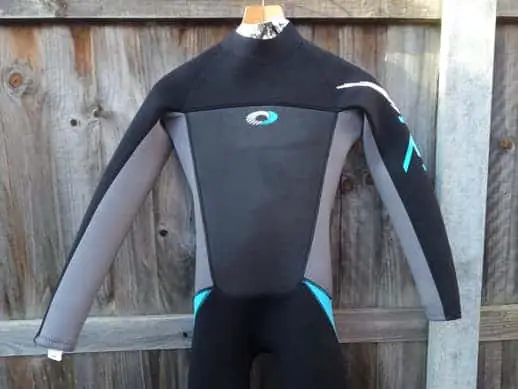
Final Thoughts
Long-term exposure of my wetsuit to chlorine did accelerate the ageing, but after 50 pool swims of 40 minutes, the material is still in very good condition.
I found that washing the wetsuit after every swim to remove the chlorine definitely helped, and if you are going to place your wetsuit in chlorine regularly, you should always ensure that is well cleaned and chlorine-free after each swim.
In summary, I felt happy exposing my wetsuit to chlorine for such long periods. However, if I had paid a lot of money for this wetsuit, I think my feelings would be different.
As the wetsuit I tested was on the cheaper side, I felt OK with exposing it to lots of chlorine and regular wear and tear. However, if this was a very expensive wetsuit, I would not be so comfortable exposing it to such harsh treatment.
I guess this is personal preference as I like to look after my expensive swim gear, but if you love your wetsuit and spent a small fortune on it, try to keep it away from chlorine. With time, that beautiful soft neoprene will turn brittle and become misshapen.
If you are going to swim regularly in chlorinated water in a wetsuit, invest in a cheaper wetsuit, as with time, the chlorine will degrade the neoprene, regardless of the wetsuit cost and quality.
